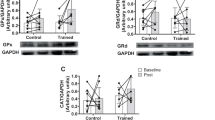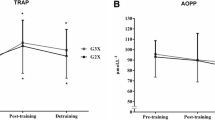Abstract
Background
Several recent studies have reported that heat stress stimulates the activation of heat shock protein 72 (HSP72), leading to an increase in muscle synthesis. Some studies suggested that low-intensity resistance training combined with heat stress could improve muscle size and strength.
Aim
This study aimed to identify the effect of low-intensity resistance training with heat stress over 12 weeks on the HSP72, anabolic hormones, muscle size, and strength in elderly women.
Methods
The subjects were physically healthy women of 65–75 years, who were randomly assigned to one of three groups: a low-intensity resistance training with heating sheet group (HRT group, n = 8), a moderate-intensity resistance training (RT group, n = 6), and a heating sheet group (HEAT group, n = 7). Computed tomography scans, 1-repetition maximum (1RM), and blood samples were taken pre- and post-training.
Results
The HSP72 did not vary significantly between the different groups and times. The IGF-1 and 1RM had significantly increased in all three groups after the training (respectively, p < 0.05). Moreover, the cross-sectional area (CSA) of the quadriceps showed a significantly greater increase in the HRT group than in the HEAT group (p < 0.05).
Conclusions
We found that low-intensity training with heat stress stimulated the anabolic hormones of elderly women, improving their muscle strength and hypertrophy. We believe that low-intensity training with heat stress is an effective way to prevent muscle atrophy and to improve muscle strength in elderly women.



Similar content being viewed by others
References
Park SW, Goodpaster BH, Lee JS et al (2009) Excessive loss of skeletal muscle mass in older adults with type 2 diabetes. Diabetes Care 32:1993–1997
Visser M, Kritchevsky SB, Goodpaster BH et al (2002) Leg muscle mass and composition in relation to lower extremity performance in men and women aged 70 to 79: the health, aging and body composition study. J Am Geriatr Soc 50:897–904
Kirchengast S, Haslinger B (2008) Gender differences in health-related quality of life among healthy aged and old-aged Austrians: cross-sectional analysis. Gend Med 5:270–278
Fisher NM, Pendergast DR, Calkins EC (1990) Maximal isometric torque of knee extension as a function of muscle length in subjects of advancing age. Arch Phys Med Rehabil 71:729–734
Gordon BA, Benson AC, Bird SR et al (2009) Resistance training improves metabolic health in type 2 diabetes: a systematic review. Diabetes Res Clin Pract 83:157–175
Rubenstein LZ (2006) Falls in older people: epidemiology, risk factors and strategies for prevention. Age Ageing 35:ii37–ii41
Kryger AI, Andersen JL (2007) Resistance training in the oldest old: consequences for muscle strength, fiber types, fiber size, and MHC isoforms. Scand J Med Sci Sports 17:422–430
Schoenfeld BJ, Peterson MD, Ogborn D et al (2015) Effects of low-vs. high-load resistance training on muscle strength and hypertrophy in well-trained men. J Strength Cond Res 29:2954–2963
Goto K, Sato K, Takamatsu K (2003) A single set of low intensity resistance exercise immediately following high intensity resistance exercise stimulates growth hormone secretion in men. J Sports Med Phys Fit 43:243
Uehara K, Goto K, Kobayashi T et al (2004) Heat-stress enhances proliferative potential in rat soleus muscle. Jpn J Physiol 54:263–271
Kraemer WJ, Ratamess NA (2005) Hormonal responses and adaptations to resistance exercise and training. Sports Med 35:339–361
Goldspink DF, Garlick PJ, McNurlan MA (1983) Protein turnover measured in vivo and in vitro in muscles undergoing compensatory growth and subsequent denervation atrophy. Biochem J 210:89–98
Ohira H, Sato Y, Ueno T et al (2002) Fenofibrate treatment in patients with primary biliary cirrhosis. Am J Gastroenterol 97:2147–2149
Sinha-Hikim I, Artaza J, Woodhouse L et al (2002) Testosterone-induced increase in muscle size in healthy young men is associated with muscle fiber hypertrophy. Am J Physiol Endocrinol Metab 283:E154–E164
Vandenburgh HH (1987) Motion into mass: how does tension stimulate muscle growth? Med Sci Sports Exerc 19(Suppl.):S142–S149
Goto K, Oda H, Kondo H et al (2011) Responses of muscle mass, strength and gene transcripts to long-term heat stress in healthy human subjects. Eur J Appl Physiol 111:17–27
Goto K, Okuyama R, Sugiyama H et al (2003) Effects of heat stress and mechanical stretch on protein expression in cultured skeletal muscle cells. Pflügers Archiv 447:247–253
Goto K, Honda M, Kobayashi T et al (2004) Heat stress facilitates the recovery of atrophied soleus muscle in rat. Jpn J Physiol 54:285–293
Mündel T, King J, Collacott E et al (2006) Drink temperature influences fluid intake and endurance capacity in men during exercise in a hot, dry environment. Exp Physiol 91:925–933
Lee JS, Kim CG, Seo TB et al (2015) Effects of 8-week combined training on body composition, isokinetic strength, and cardiovascular disease risk factors in older women. Aging Clin Exp Res 27:179–186
Kalapotharakos VI, Michalopoulou M, Godolias G et al (2004) The effects of high-and moderate-resistance training on muscle function in the elderly. J Aging Phys Act 12:131–143
Brzycki M (1993) Strength testing-predicting a one-rep max from reps-to-fatigue. J Phys Educ Recreat Dance 64:88–90
Goodpaster BH, Carlson CL, Visser M et al (2001) Attenuation of skeletal muscle and strength in the elderly: the health ABC study. J Appl Physiol 90:2157–2165
Sarge KD, Murphy SP, Morimoto RI (1993) Activation of heat shock gene transcription by heat shock factor 1 involves oligomerization, acquisition of DNA-binding activity, and nuclear localization and can occur in the absence of stress. Mol Cell Biol 13:1392–1407
Kiang JG, Tsokos GC (1998) Heat shock protein 70 kDa: molecular biology, biochemistry, and physiology. Pharmacol Ther 80:183–201
Thompson HS, Maynard EB, Morales ER et al (2003) Exercise-induced HSP27, HSP70 and MAPK responses in human skeletal muscle. Acta Physiol Scand 178:61–72
Yoshihara T, Naito H, Kakigi R et al (2013) Heat stress activates the Akt/mTOR signalling pathway in rat skeletal muscle. Acta Physiol 207:416–426
Lee JS, Seo JS (2002) Differential expression of two stress-inducible hsp70 genes by various stressors. Exp Mol Med 34:131–136
Valls MRB, Dimauro I, Brunelli A et al (2014) Explosive type of moderate-resistance training induces functional, cardiovascular, and molecular adaptations in the elderly. Age 36:759–772
Paulsen G, Vissing K, Kalhovde JM et al (2007) Maximal eccentric exercise induces a rapid accumulation of small heat shock proteins on myofibrils and a delayed HSP70 response in humans. Am J Physiol Regul Integr Comp Physiol 293:R844–R853
Murlasits Z, Cutlip RG, Geronilla KB et al (2006) Resistance training increases heat shock protein levels in skeletal muscle of young and old rats. Exp Gerontol 41:398–406
Pandini G, Mineo R, Frasca F et al (2005) Androgens up-regulate the insulin-like growth factor-I receptor in prostate cancer cells. Cancer Res 65:1849–1857
Harridge SD, Kryger A, Stensgaard A (1999) Knee extensor strength, activation, and size in very elderly people following strength training. Muscle & Nerve 22:831–839
Acknowledgements
This research was supported by the National Research Foundation of Korea (NRF) Grant funded by the Korea Government (Ministry of Science, ICT & Future Planning) (No. 2015S1A5A2A01012405).
Author information
Authors and Affiliations
Corresponding author
Ethics declarations
Conflict of interest
The authors declare that they have no conflict of interest.
Statement of human and animal rights
All procedures performed in studies involving human participants were in accordance with the ethical standards of the 1964 Helsinki Declaration and its later amendments. No studies with animals were performed.
Ethical approval
The study was approved by the Bioethics Committee (Institutional Review Board) of Korea University (KU-IRB-14-44-A-1) and complied with the standards set by the Declaration of Helsinki.
Informed consent
Informed consent was obtained from all individual participants included in the study.
Rights and permissions
About this article
Cite this article
Yoon, S.J., Lee, M.J., Lee, H.M. et al. Effect of low-intensity resistance training with heat stress on the HSP72, anabolic hormones, muscle size, and strength in elderly women. Aging Clin Exp Res 29, 977–984 (2017). https://doi.org/10.1007/s40520-016-0685-4
Received:
Accepted:
Published:
Issue Date:
DOI: https://doi.org/10.1007/s40520-016-0685-4




